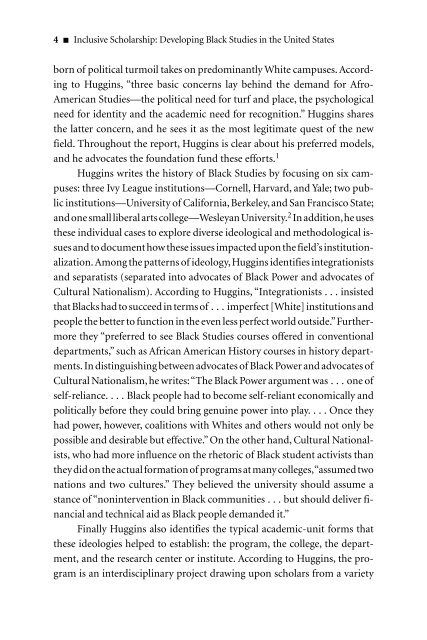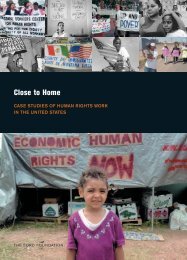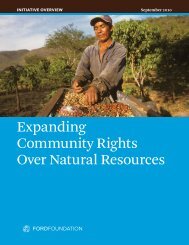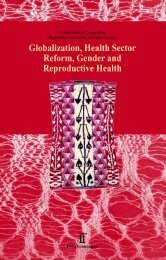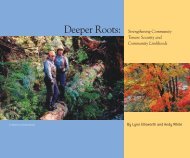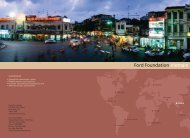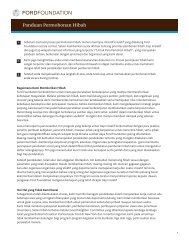Inclusive Scholarship: Developing Black Studies - Ford Foundation
Inclusive Scholarship: Developing Black Studies - Ford Foundation
Inclusive Scholarship: Developing Black Studies - Ford Foundation
Create successful ePaper yourself
Turn your PDF publications into a flip-book with our unique Google optimized e-Paper software.
4 <strong>Inclusive</strong> <strong>Scholarship</strong>: <strong>Developing</strong> <strong>Black</strong> <strong>Studies</strong> in the United States<br />
born of political turmoil takes on predominantly White campuses. According<br />
to Huggins, “three basic concerns lay behind the demand for Afro-<br />
American <strong>Studies</strong>—the political need for turf and place, the psychological<br />
need for identity and the academic need for recognition.” Huggins shares<br />
the latter concern, and he sees it as the most legitimate quest of the new<br />
field. Throughout the report, Huggins is clear about his preferred models,<br />
and he advocates the foundation fund these efforts. 1<br />
Huggins writes the history of <strong>Black</strong> <strong>Studies</strong> by focusing on six campuses:<br />
three Ivy League institutions—Cornell, Harvard, and Yale; two public<br />
institutions—University of California, Berkeley, and San Francisco State;<br />
and one small liberalartscollege—WesleyanUniversity. 2 Inaddition,heuses<br />
these individual cases to explore diverse ideological and methodological issues<br />
and to document how these issues impacted upon the field’s institutionalization.<br />
Among the patterns of ideology,Huggins identifies integrationists<br />
and separatists (separated into advocates of <strong>Black</strong> Power and advocates of<br />
Cultural Nationalism). According to Huggins, “Integrationists ... insisted<br />
that <strong>Black</strong>s had to succeed in terms of ... imperfect [White] institutions and<br />
people the better to function in the even less perfect world outside.”Furthermore<br />
they “preferred to see <strong>Black</strong> <strong>Studies</strong> courses offered in conventional<br />
departments,” such as African American History courses in history departments.<br />
In distinguishing between advocates of <strong>Black</strong> Power and advocates of<br />
Cultural Nationalism, he writes:“The <strong>Black</strong> Power argument was ... one of<br />
self-reliance. ... <strong>Black</strong> people had to become self-reliant economically and<br />
politically before they could bring genuine power into play. ... Once they<br />
had power, however, coalitions with Whites and others would not only be<br />
possible and desirable but effective.” On the other hand, Cultural Nationalists,<br />
who had more influence on the rhetoric of <strong>Black</strong> student activists than<br />
theydidontheactualformationof programsatmanycolleges,“assumedtwo<br />
nations and two cultures.” They believed the university should assume a<br />
stance of “nonintervention in <strong>Black</strong> communities ... but should deliver financial<br />
and technical aid as <strong>Black</strong> people demanded it.”<br />
Finally Huggins also identifies the typical academic-unit forms that<br />
these ideologies helped to establish: the program, the college, the department,<br />
and the research center or institute. According to Huggins, the program<br />
is an interdisciplinary project drawing upon scholars from a variety


